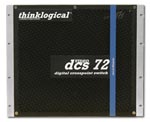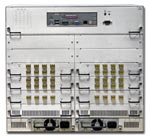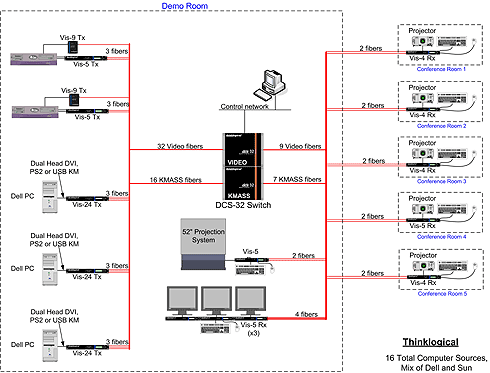Thinklogical DCS-32, DCS-72, DCS-144 Digital Crosspoint Switch |  
Thinklogical Digital Crosspoint Switch
| 
|
The DCS series of fiber-in, fiber-out matrix switches adds simplicity and control to sophisticated video and KVM visual computing environments. The DCS, or "digital cross-point switch", provides transparent, highly reliable and secure routing of video and human interface device signals from any input to any or multiple outputs. As an accessory designed to be integrated with the entire line of Thinklogical video and KVM extenders, the DCS switches can make connections between virtually any transmitter and receiver easily and securely.
The concept for simplifying complex computer user interface environments (video, KVM, etc.) is simple. The multitude of various video, keyboard, mouse, USB, audio, and serial connections from computer sources all connect to a transmitter using very short standard cabling. The transmitter converts all these signals to fiber optics. By using only one fiber optic cable strand for video and one additional fiber for all of the non-video signals (keyboard, mouse, audio, etc.), the computer interface copper cable management challenges are reduced to routing one or two fibers to the desired destination receiver. At the receiver end the process is reversed and the optical data is converted back to electronics and standard copper cable connections. Copper cables then connect to their associated desktop and display devices. This basic fiber optic KVM extension example works well when the customer always wants a particular source to connect to a particular destination. For smaller applications, this point to point approach works well. For larger environments, however, the need to switch different types of sources to a variety of destinations dictates the need for a matrix switch. The DCS series of switches is Thinklogical's answer to this challenge.
The need for fiber:
Important things to consider when designing a switched environment start with distance. Distance and the physics associated with copper cables is what kills video signals and creates erratic mouse performance, ground loops and innumerable other problems and, in general, creates the need for fiber optic technology to get the job done. The first goal in any video or KVM extension application is to keep the copper cable component of the system to an absolute minimum length. It is important to know that newer, higher speed, digital video technologies, such as DVI, are much more sensitive to copper cable lengths than the traditional analog RGB technologies. Fiber optic extenders from Thinklogical leverage the excellent attenuation, bandwidth and skew characteristics of fiber optic cable to solve the copper nightmare.
Copper cable distance limitations virtually eliminates the prospect of using traditional copper matrix switches due to the physical problem of locating computers close enough to the switch to keep the cable lengths short. If copper cables are used, the diameter of each cable needs to increase as the distances increase. This creates substantial cable management issues at every turn and connection. The DCS is a fiber-in and fiber-out, fully non-blocking, matrix switch with no copper cable connections at all, other than power. The combination of fiber optic transmitters and receivers and the DCS absolutely minimizes the copper issues. The same concept is true for keyboards and mice. The system transmitter converts every input to a common digital format and then, at the receiver, supports PS2, USB and legacy Sun. No matter what keyboard and mouse the source computer has, it will work with whatever type is on the desktop. All remapping and translations are done in the system.
So, no more worries about compatibility. This is important to remember when sources are switch to a variety of destinations. The DCS does not do any signal processing, translating or conversion (other than optical to electronic to optical). The DCS is a completely digital transparent routing conduit for the attached input and output fibers. 
Thinklogical Digital Crosspoint Switch Series (Diagram I)
The diagram above shows a simple implementation of fiber extenders connecting a variety of sources to a variety of destinations without compatibility issues associated with legacy copper systems.
Cable management made easy
The DCS is chassis based, modularized automated patching device, or matrix switch. All connections to and from the DCS are made through fiber optic LC connectors. LCs allow for excellent port density and have positive latching for retention. For a typical KVM connection there would be two fibers, one for video and one for "KMASS" (keyboard, mouse, audio, serial and stereographics). The video fiber connects to a DCS video chassis and the KMASS fiber connects to a KMASS chassis. The two chassis'are connected to each other and communicate via SNMP allowing them to perform switching functions as one. Cable management is reduced to fiber management and may be accomplished with or without patch panels prior to input connection or after output connection.
Controlling the DCS
The DCS may be controlled from a browser session on a private network or through a serial connection. The switch comes with an installed GUI user interface which allows users with permission to make and break connections, view existing connections and change their passwords. An administrator level access is supported for maintenance of the switch, software upgrades, diagnostic monitoring, port set-up, port editing and port deletions as well as various user and group set-up. Administrators also determine permissions, initial passwords, switch schedules, and port locking and unlocking. The complete extension and switching solution
To appreciate the true value of the DCS series of matrix (cross-point) switches, a firm understanding of the complete line of Thinklogical fiber extenders is in order. Thinklogical has eliminated the need for video converter boxes (VDAs), dongles, keyboard and mouse translators, sync converters and splitters. All these things, and more, have been built right into the transmitters and receivers.
Thinklogical has fiber extender models that support both DVI and RGB, just DVI, just RGB, dual-link DVI, dual head, DDC, no DDC, PS2, USB and legacy Sun keyboards and mice, serial and USB devices and so on. No matter what type of computer human interface you need to extend, Thinklogical has a product to do it.
The Thinklogical extension technology permits customers to convert to DVI from RGB at their own pace. A Thinklogical receiver can output DVI even though the source connection to the transmitter is RGB, and vice versa. Keyboards and mice are translated and remapped to comply with whatever is attached, automatically.
The fiber count is kept to a minimum. One fiber for one video feed, whether DVI or RGB, and one more for everything else. Once all the signals have been converted to fiber optics and connected to the DCS, customers can quickly, easily and securely, control where they are routed within the user environment.
Thinklogical DCS Series FEATURES
Full Non-blocking matrix switch performance - Broadcast (one to all) and multicast (one to more than one) connection capability.
- Any source port(s) may be connected to any destination Port(s)
Chassis-based hardware configuration
- Video chassis connects any video fiber to any video fiber no matter what the source and destination device video format is, RGB or DVI.
- KMASS chassis connects all non-video fibers. KMASS is an acronym for Keyboard, Mouse, Audio, Serial and Stereo (3D graphics).
- All chassis'connect together and function as one using SMNP. This permits ports in the video chassis to switch concurrently with associated KMASS ports.
- Each chassis has a dedicated on-board Linux cpu (pc) module for control and administration. These cpu modules may be accessed via a network connection (browser), or a serial port for 3rd party controller (AMX, Crestron, etc.) integration.
Scalable and Modular Design - Each chassis may be scaled in 8 port (DCS-32) or 16 port (DCS-72 and DCS-144) increments as customer requirements dictate.
- Each chassis is made up of the following modules:
-Linux cpu module
-Input (source) port module(s)
-Output (destination) port module(s)
-Fan modules and trays
-Power supply modules (current sharing, redundant)
-8-port input and output modules (DCS-72 only) - All modules and trays are hot-swappable, except the cpu.
On-board diagnostics - Each chassis has a Linux controller, which can determine whether or not an optical signal is present, possibly indicating a fiber disconnect or breakage.
- Voltage monitoring
- Fan speed monitoring
- Temperature monitoring
- S.M.A.R.T. Drive diagnostics
- SNMP management functions
- Complete suite of Linux administrative functions and diagnostics
Cable management
- Fiber in and fiber out eliminates all copper cable issues associated with traditional matrix switches.
- Single fiber connection supports a complete RGB or DVI video signal
- Single fiber connection supports all non-video signals associated with a workstation, including keyboard, mouse, USB, serial, stereo graphics, and full duplex stereo analog audio.
- Fiber connectivity may be ST, SC or LC depending upon extender model.
- All Thinklogical fiber products use multimode fiber.
- DCS fiber connectors are LC for high density and positive lock connections.
- Copper cabling is limited to connecting source computers to Thinklogical fiber transmitters and display and desktop devices to Thinklogical fiber receivers.
- This permits copper cable (length) related artifacts and performance issues to be minimized.
Security - The DCS retains no video or KMASS information in any type of memory format.
- The DCS is a conduit for routing signals from an input port to an output port.
- Information through the switch is indecipherable without a fiber optic transmitter and receiver.
- Return signals through the KMASS switch may be turned off to assure there is no unintended path from the user back to the cpu through the DCS.
- Since the DCS routs user interface device signals, including video, in a proprietary way, there is isolation between switched signals and networks.
- Fiber optic cables are immune to EMI and RFI security concerns and eliminate electronic eavesdropping.
- Users may be grouped and given group-specific rights and permissions pertaining to computers they may switch to.
- Administrators have total access to the DCS diagnostics and may create, edit and delete users, sources, destinations and groups.
- All users must login with a unique user ID and password prior to making or breaking connections.
Graphical User Interface
- Easy to use browser-based GUI allows users to select a computer or source by name and connect to a user destination by name.
- Groups of ports may be created and switched simultaneously.
- Any individual video (and/or audio) source may be multicast or broadcast to multiple destinations. (Note: "Multicast" is defined as one source to more than one destination and "broadcast" is defined as one source to all destinations.)
- Users may be created, modified or deleted by administrator level individuals.
- Administrators have complete access to many diagnostic elements via the Linux OS and SNMP.
- Connections may be locked and protected as programmed by an administrator.
- Users may make or break connections according to their permission set.
- Serial control is also available.
|

